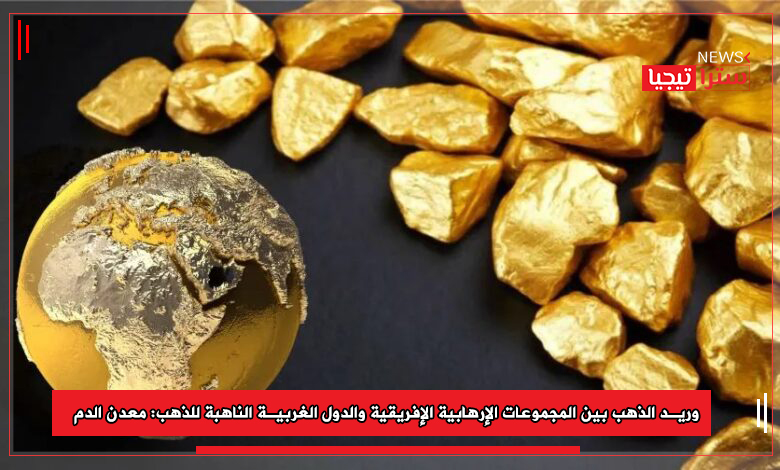by Faten Jabari: Department of International Relations and Strategic Affairs 04-04-2024

Introduction
When examining the distribution map of gold in the African continent, it becomes apparent that the regions where terrorist groups are most concentrated and active are those known as the “Saharan Gold Vein,” which stretches from Sudan in the east of the continent to Mauritania in its far west.
The conflict over gold and the assertion of influence in the states of Mali and Burkina Faso have sparked a significant conflict between terrorist groups, not only targeting government institutions but also civilians.
Among the most notorious contenders for gold are armed groups affiliated with organizations like Al-Qaeda, such as “Nusrat al-Islam wal Muslimeen,” as well as others affiliated with ISIS, such as “ISIS Greater Sahara,” alongside non-Islamic African militias.
Africa’s Share of Global Gold Reserves

According to the United Nations Environment Programme, Africa’s share of global gold amounted to 40%, with the total gold production from African mines reaching 680.3 metric tons in 2022. The African continent possesses nearly half of the world’s gold reserves. Despite these enticing figures, the fragility of political systems and the lack of law enforcement have turned Africa into a hub for international gold smuggling mafias.
Gold serves as one of the hidden drivers of conflict in the Sahel and desert regions of Africa, where armed groups and extremist militias fight to assert control over the extensive mines across the continent’s desert.
Since 2012, a rich gold vein has been discovered stretching across the desert from east to west.
These new discoveries in Chad, Niger, Mali, and Burkina Faso have increased the production and sale of this metal. In Burkina Faso, gold mining accounts for two-thirds of export revenues and 15% of the gross domestic product, besides providing 61,000 direct and indirect jobs.
According to a crisis assessment report by the International Crisis Organization, armed groups seize gold mining sites in areas where the state is weak or absent.
It is worth noting that the “Intakka Mine” in northern Mali, one of the largest gold extraction areas, has seen the spread of ISIS and the group “Nusrat al-Islam wal Muslimeen,” leading to the mine falling outside government control. This is in contrast to mines in the south and west of the country, where terrorists have not yet gained influence.

On November 6, 2022, a terrorist attack on worker transport buses at the “Bongou Mine,” owned by the Canadian gold company “Semafo,” killed 38 people and injured 60 others. These mines have become a source of income for jihadist organizations in the border triangle between Niger, Burkina Faso, and Mali.
Many rebel and terrorist movements in the African Sahel region consider gold laundering a primary source of funding and recruitment.
Al-Qaeda and ISIS offshoots in Africa target industrial mining operations and control parts of the informal gold trade in Burkina Faso, Mali, and Niger.
Reuters confirms that Islamists consider gold mines as a treasure trove of funds, enabling them to recruit new members and purchase weapons and explosives to expand their power through attacks.
In Burkina Faso, rebels have seized 24 gold extraction sites, producing gold worth $35 million annually.
In Mali and Niger, Islamic groups impose taxes on gold traders, while gold smuggling continues unabated in Ghana, Ivory Coast, Nigeria, and Zimbabwe.
Global Companies Compete for Control of African Gold

Another aspect of the conflict lies between international mining companies themselves. There are six competing international companies in Mali’s gold mines, some based in Canada and others in Britain, alongside companies headquartered in South Africa.
In Sudan, gold is widespread from most northern cities, specifically from the extreme north to near the capital Khartoum, from the eastern coast on the Red Sea to the Red Sea mountain range to the far west near Jebel Aweinat and Al-Tiina in Darfur.
Sudan: The Citadel of Gold

Gold is found in high concentrations in northern Sudan from Wadi Halfa to Atbara, along with other minerals like copper, zinc, and iron due to its geographical terrain.
Gold is found in high concentrations, reaching up to 100 tons in some places, in the Red Sea Mountains, accompanied by silver in the south of the Blue Nile State.
The yellow metal, considered the most important reserve in national treasuries, is the primary driver of conflicts and wealth in Sudan, one of the richest regions.
In addition to attempts by some active terrorist groups in the region to exploit it as a major source of funding, international warnings have been issued that extremist groups in Mali, Burkina Faso, and Niger have found gold mines as a new source of financing, providing an environment conducive to recruiting members. These groups and powers focus on sources of funding, and there seems to be no more effective investment or imposition of taxes in mineral-rich areas and gold mining.

